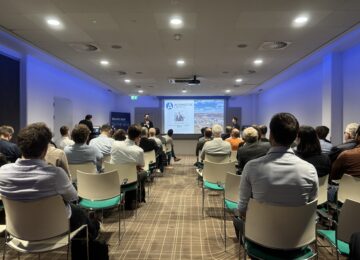Eneco and Corre Energy join forces for compressed air energy storage project
Corre Energy, a Dutch specialist in long-term energy storage, has partnered with Eneco to implement its first compressed air energy storage (CAES) project in Germany. Eneco will acquire 50% of the project. Corre Energy says that underground energy storage in the form of compressed air and green hydrogen could be one of the cheapest forms of energy storage.
Groningen-based Corre Energy has signed an agreement with Dutch energy company Eneco for off-take, co-development and co-investment of a compressed air energy storage project in Ahaus, Germany. The project is based on four salt domes in the German state of North Rhine-Westphalia with the potential to host a 500 MW storage system. Eneco will operate, co-develop and finance the project through its German subsidiary LichtBlick, one of the largest green energy suppliers in Germany. Construction of the domes has already begun, with completion of the first two expected in early 2027.
Phase one of the Ahaus project will use two of the site's existing salt domes to deploy Corre Energy's multi-day CAES solution for 220 MW of compression capacity and 320 MW of generation capacity. The project is expected to use equipment from Siemens Energy. Under the agreement, Eneco will acquire a 50% interest in the project on yet-to-be-agreed economic terms consisting of both development and construction capital. "The agreement, which is subject to approvals from respective boards, significantly reduces Corre Energy's risk on both commercial completion and FID [final investment decision]," Corre Energy said.
"This groundbreaking agreement combines off-take, development and co-investment arrangements to advance our first German project while showcasing the latest demand for our CAES solution," said Keith McGrane, CEO of Corre Energy.
This transaction represents the second agreement between Eneco and Corre Energy, following the 15-year offtake agreement for the ZW1 project in the Netherlands, announced in December 2022. "By establishing long-term investment partnerships like in Germany, we accelerate the commercial development of our portfolio, supported by long-term offtake agreements. These agreements are repeatable across the portfolio and for each project can generate approximately €1 billion in net revenue over the term of a 15-year offtake agreement," McGrane said.
The cooperation enables Eneco to use the full capacity of the first phase of the project in Ahaus once it is completed in 2027. Currently, chemical company Solvay is still extracting salt from the domes. "We see a promising future for these storage solutions, and this second project with Corre Energy brings us closer to achieving the goals set in our One Planet Plan: to be climate neutral by 2035, together with our customers," said Kees-Jan Rameau, COO - Integrated Energy at Eneco.
According to the project partners, the CAES site in Ahaus is well located between increasing offshore wind energy production in the north and significant power consumption regions in the south. It is close to the future national hydrogen backbone (H2-Startnetz) and will complement the regional establishment of an industrial-scale green energy-based green hydrogen value chain. The project represents the first CAES plant developed, built and operated in Germany since 1978, when the 321 MW Huntorf plant was completed as the world's first CAES plant. In recent years alone, several large-scale projects have been announced in the United States, Israel, Canada, Australia and China. However, there has been considerable limitation in the application rate of CAES because of its reliance on underground fields for storage.
Source: pv magazine





